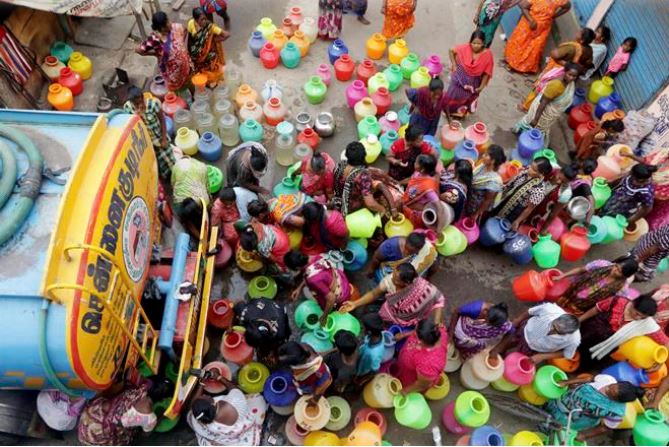
Chennai, one of India’s largest cities, is currently facing a severe water crisis that has captured national and international attention. With a population exceeding 10 million, the city once thrived on its diverse water sources, including lakes, rivers, and groundwater. However, a combination of prolonged drought, rapid urbanization, and poor resource management led to an unprecedented situation where reservoirs have dried up and groundwater level plummeted. In fact, Chennai had gone without significant rainfall for over 200 days in 2019, pushing it to the brink of becoming a “zero city”—a term that signifies a complete lack of accessible water. This crisis not only disrupted daily life for residents but also posed significant challenges for businesses and the government. As I explore this pressing issue, I aim to shed light on the causes, impacts, and potential solutions to Chennai’s water crisis.
Understanding the Causes of Chennai’s Water Crisis
Chennai’s water crisis stems from several interrelated factors. First and foremost is climate change. The city has experienced erratic rainfall patterns over the years, leading to severe droughts. In fact, Chennai went without rain for more than 200 days recently, marking its worst water crisis in 30 years. This lack of precipitation has severely depleted the city’s four major reservoirs—Red Hills, Cholavaram, Poondi, and Chembarambakkam—which now hold less than 1% of their capacity.
Rapid urbanization further complicates the situation. The city’s population is projected to grow significantly in the coming years, increasing demand for water resources. Currently, Chennai requires approximately1400 million liters per day (MLD), but only about 1040 MLD is supplied, leaving a deficit in supply of 360 MLD. Alarmingly, the water requirement of Chennai is expected to rise to 2100 MLD by 2031. This imbalance could create a chronic shortage that affects millions.
Moreover, groundwater depletion plays a critical role in this crisis. Many residents rely on borewells for their water supply; however, over-extraction has caused groundwater levels to drop alarmingly. The Chennai Metropolitan Water Supply and Sewerage Board (CMWSSB) reports that extraction rates are nearly double the annual recharge rates. This unsustainable practice threatens not just current supply but also future availability.
Daily Life Affected by Water Shortage
The impact of Chennai’s water shortage is felt acutely in everyday life. Families struggle to secure enough clean water for basic needs such as cooking and bathing. Schools have faced closures due to inadequate facilities, while businesses grapple with operational disruptions caused by limited water access.
Residents often find themselves waiting weeks for private water tankers to arrive. These tankers have become a lifeline for many neighborhoods but come at a high cost—both financially and emotionally. As one frustrated resident noted, “Water is no longer a basic right; it has become a luxury.” This sentiment resonates deeply across the city as people stand in long lines with containers in hand, hoping to fill them with precious water.
The disparity in access further exacerbates social tensions within Chennai. Wealthier neighborhoods can afford private tankers at inflated prices while poorer communities are left struggling with dry taps and empty wells. This inequity raises critical questions about resource allocation and social justice in times of crisis.
Measures to Address Water Scarcity
In response to this escalating crisis, various measures are being implemented to address water scarcity in Chennai. The government has initiated programs promoting rainwater harvesting systems in both residential and commercial buildings. These systems can help recharge groundwater levels effectively if maintained properly.
Moreover, the Greater Chennai Corporation is restoring ancient temple tanks and building new ones to store water for dry months. The project is supported by the Dutch government and the Asian Infrastructure Investment Bank. Besides, the World Bank and KfW (German Development Bank) have funded storm water drains and underground drain projects in the Kovalam basin. The Asian Development Bank (ADB) is also supporting water supply and sewerage system improvement.
The CMWSSB is also working on improving infrastructure for better water distribution and reducing leaks within existing systems. However, these initiatives require robust implementation and community involvement to be truly effective.
The government has also taken steps to conserve water, including enumerating and geo-tagging water bodies, setting up Jal Shakti Kendras and intensive afforestation.
Community engagement plays a vital role in fostering a culture of conservation. Local organizations are actively organizing awareness campaigns about efficient water usage and conservation practices. These grassroots movements are essential for driving change at the community level.
Comparing Chennai’s Crisis with Other Indian Cities
Chennai’s situation is not unique; other Indian cities face similar challenges due to rapid urbanization and climate change. Cities like Bengaluru and Delhi also struggle with severe water shortages but have different underlying issues contributing to their crises.
For instance, Bengaluru has seen its main sources of drinking water dwindle as urban sprawl encroaches on vital lakes and rivers. Meanwhile, Delhi grapples with an even larger population growth that exacerbates its already strained resources.
Understanding these comparisons highlights the need for tailored solutions that consider each city’s unique circumstances while learning from one another’s experiences.
Groundwater Depletion: A Major Concern
Groundwater depletion is one of the most pressing issues contributing to Chennai’s water crisis. Over-extraction has led to alarming drops in groundwater levels across the city. In many neighborhoods, borewells have run dry entirely.
The CMWSSB reported that extraction rates are nearly double what can be sustainably replenished through natural recharge processes. This unsustainable practice threatens not only current supply but also future availability.
As Professor L Elango stated, “If we do not manage our groundwater wisely, we will face dire consequences.” His warning underscores the urgency of addressing this critical issue before it spirals further out of control.
Effective Water Conservation Strategies for Residents
Amidst this dire situation, residents can take proactive steps to conserve water effectively so as to tide over times of extreme crisis. Simple practices like fixing leaks can save significant amounts daily without much effort. Additionally, using buckets instead of hoses for cleaning can drastically reduce wastage.
Installing low-flow fixtures can help minimize overall consumption while maintaining comfort levels within homes. Furthermore, community awareness programs can educate residents about effective conservation techniques that can be easily implemented at home.
Long-Term Solutions for Future Water Security
To prevent future crises from arising in Chennai requires long-term solutions must be prioritized across various sectors. Sustainable urban planning should focus on integrating effective water resource management into development projects.
Investing in desalination plants could provide an alternative source of potable water for the city; however, these projects require careful consideration due to their high costs and environmental impacts.
As Dr. Raghuram Rajan emphasized: “We must think beyond immediate fixes and invest in sustainable solutions.” This approach will ensure that future generations have access to clean drinking water without compromising environmental integrity.
CMWSSB’s Role in Addressing Water Shortages
The CMWSSB plays an essential role in managing Chennai’s complex water supply system. They oversee distribution efforts while also addressing sewage management concerns throughout the city.
However, their effectiveness often suffers due to inadequate infrastructure funding and support from government bodies. Enhanced training programs for staff could lead to improved management practices within the organization as well.
Business Adaptation Amid Water Scarcity
Businesses across Chennai are adapting their operations amid ongoing water scarcity challenges as well. Many companies invest in rainwater harvesting systems or explore ways to recycle wastewater for non-potable uses efficiently.
These adaptations come at significant costs; companies must balance operational needs against financial constraints while navigating this challenging landscape.
Holistic Changes Needed for Effective Solutions
To tackle Chennai’s water crisis effectively requires holistic changes across various sectors:
- Policy Reforms: Implement strict regulations on groundwater extraction.
- Community Engagement: Foster local initiatives promoting conservation.
- Investment in Infrastructure: Upgrade existing systems for efficiency.
- Education Programs: Increase public awareness about sustainable practices like tree planting.
As I reflect on this current situation together with you as readers interested in this topic—it becomes clear that change is essential! The people of Chennai must unite as a community committed towards addressing this pressing issue together!
In conclusion, Chennai’s ongoing water crisis demands immediate action from all stakeholders—government bodies and businesses alike! Prioritizing sustainable practices alongside innovative solutions will be crucial, moving forward! What steps need to be taken immediately? Express India, express your thoughts below!

Now things are changing. Chennai gets frequent rains and aquifers are getting recharged.
In any metropolis as the population increases there is bound to be problems like water, electricity, sewage disposal etc.
Citizens are to be educated to collect and use grey water, RO wastewater from their water filters and overall austerity measures like regulating the flow from taps, use of aerators etc.